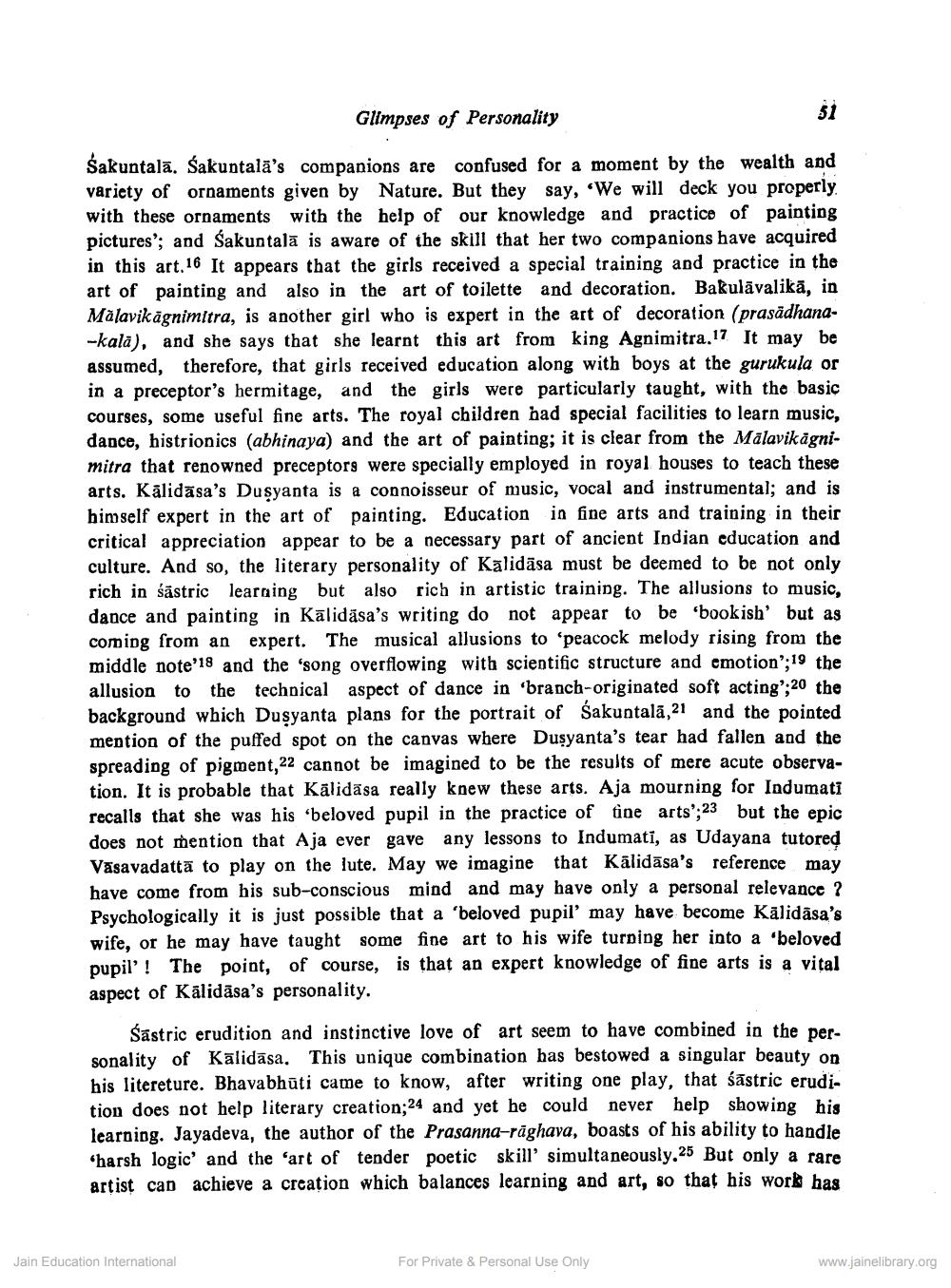________________
Glimpses of Personality
Sakuntalā. Sakuntala's companions are confused for a moment by the wealth and variety of ornaments given by Nature. But they say, "We will deck you properly with these ornaments with the help of our knowledge and practice of painting pictures'; and Śakuntalā is aware of the skill that her two companions have acquired in this art.16 It appears that the girls received a special training and practice in the art of painting and also in the art of toilette and decoration. Bakulāvalikā, in Malavikāgnimitra, is another girl who is expert in the art of decoration (prasādhana-kalā), and she says that she learnt this art from king Agnimitra.17 It may be assumed, therefore, that girls received education along with boys at the gurukula or in a preceptor's hermitage, and the girls were particularly taught, with the basic courses, some useful fine arts. The royal children had special facilities to learn music, dance, histrionics (abhinaya) and the art of painting; it is clear from the Malavikāgnimitra that renowned preceptors were specially employed in royal houses to teach these arts. Kālidāsa's Duşyanta is a connoisseur of music, vocal and instrumental; and is himself expert in the art of painting. Education in fine arts and training in their critical appreciation appear to be a necessary part of ancient Indian education and culture. And so, the literary personality of Kālidāsa must be deemed to be not only rich in śāstric learning but also rich in artistic training. The allusions to music, dance and painting in Kālidāsa's writing do not appear to be 'bookish' but as coming from an expert. The musical allusions to 'peacock melody rising from the middle note'18 and the 'song overflowing with scientific structure and emotion”;19 the allusion to the technical aspect of dance in 'branch-originated soft acting’: 20 the background which Dusyanta plans for the portrait of Sakuntalā,21 and the pointed mention of the puffed spot on the canvas where Duşyanta's tear had fallen and the spreading of pigment,22 cannot be imagined to be the results of mere acute observation. It is probable that Kālidasa really knew these arts. Aja mourning for Indumati recalls that she was his beloved pupil in the practice of tine arts”;23 but the epic does not mention that Aja ever gave any lessons to Indumati, as Udayana tutored Vasavadattā to play on the lute. May we imagine that Kālidāsa's reference may have come from his sub-conscious mind and may have only a personal relevance ? Psychologically it is just possible that a 'beloved pupil' may have become Kalidasa's wife, or he may have taught some fine art to his wife turning her into a 'beloved pupil'! The point, of course, is that an expert knowledge of fine arts is a vital aspect of Kālidāsa's personality.
Šāstric erudition and instinctive love of art seem to have combined in the personality of Kālidāsa. This unique combination has bestowed a singular beauty on his litereture. Bhavabhūti came to know, after writing one play, that śāstric erudition does not help literary creation;24 and yet he could never help showing his learning. Jayadeva, the author of the Prasanna-rāghava, boasts of his ability to handle "harsh logic and the art of tender poetic skill' simultaneously.25 But only a rare artist can achieve a creation which balances learning and art, so that his work has
Jain Education International
For Private & Personal Use Only
www.jainelibrary.org




